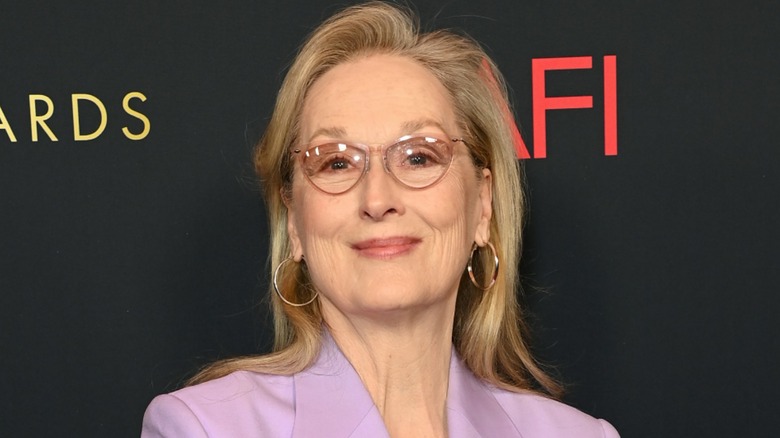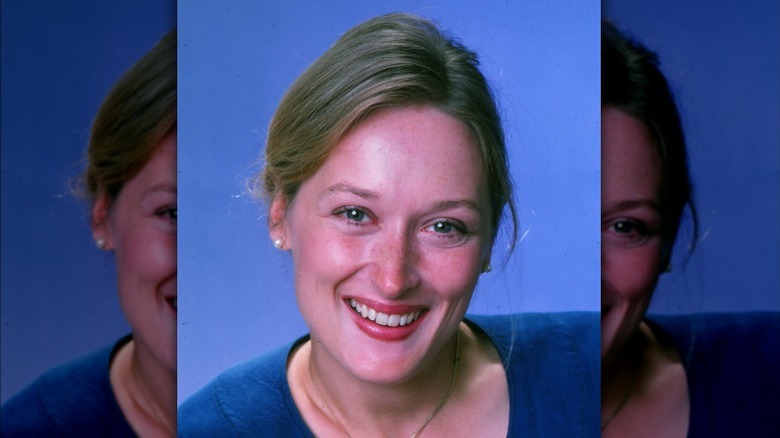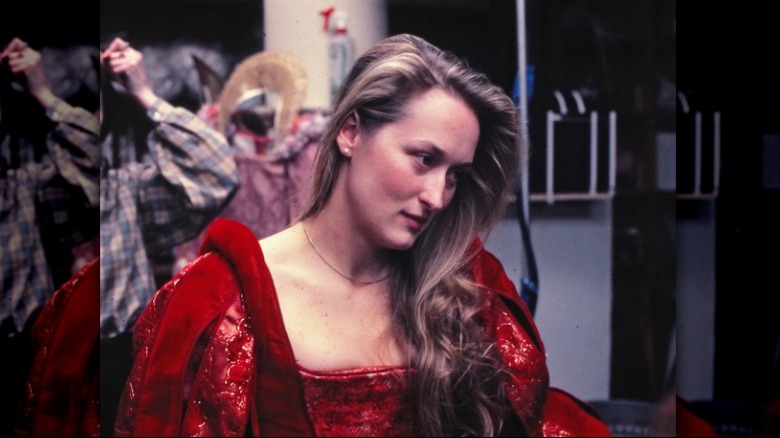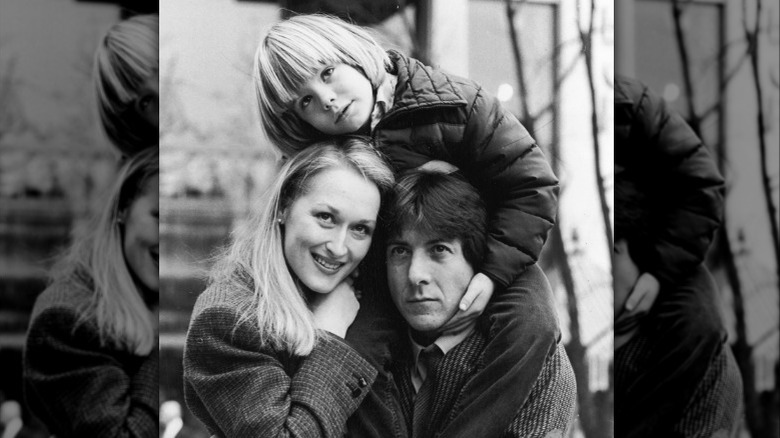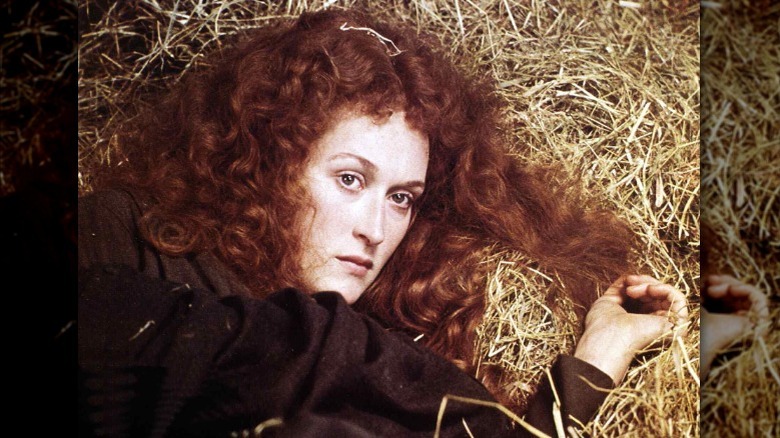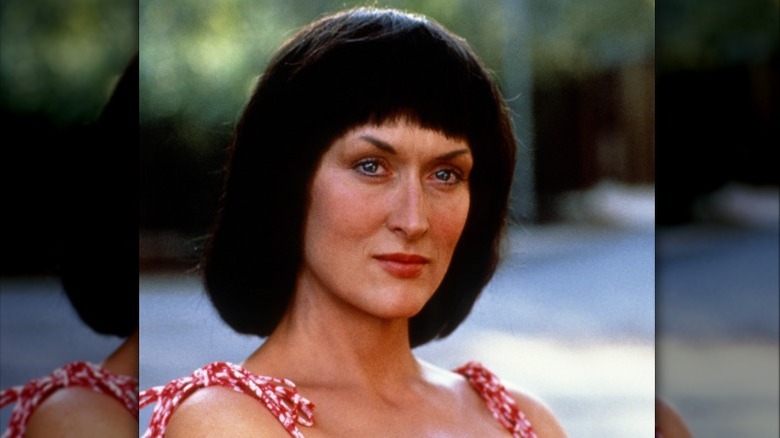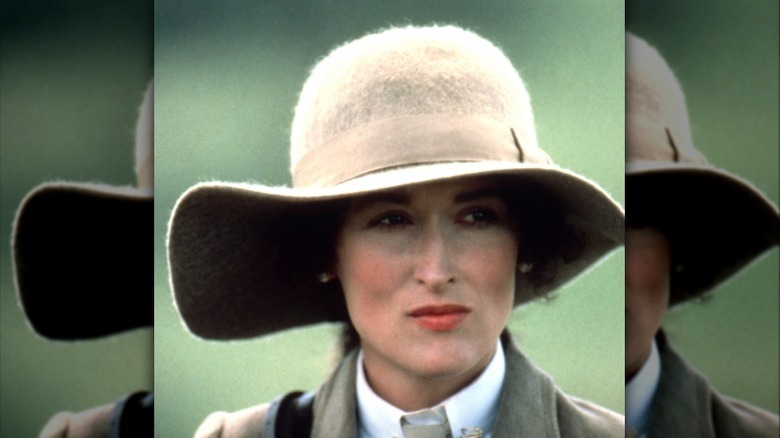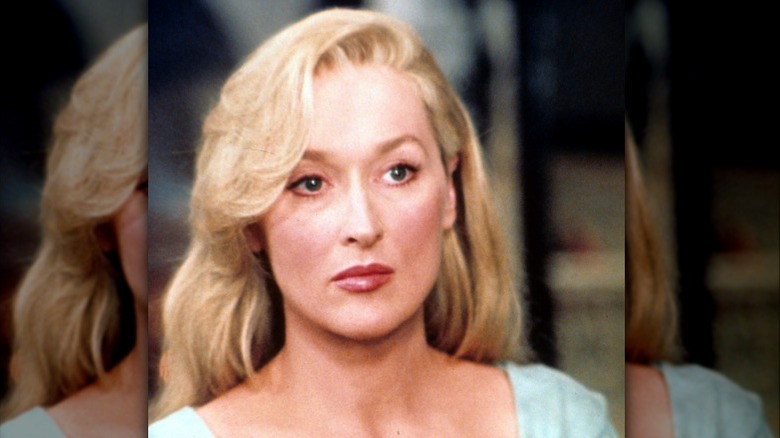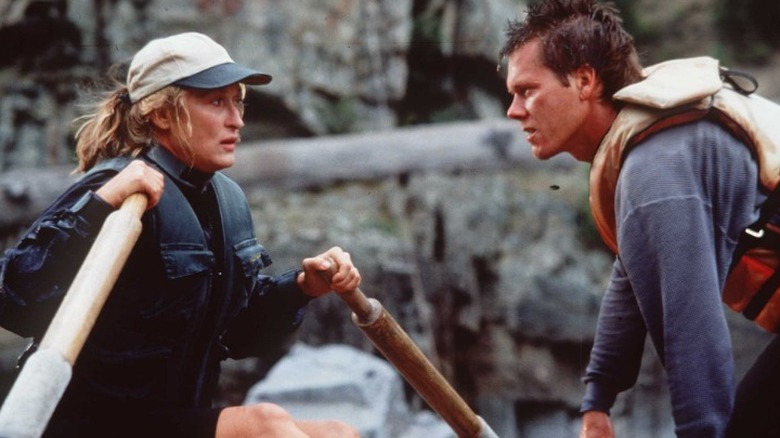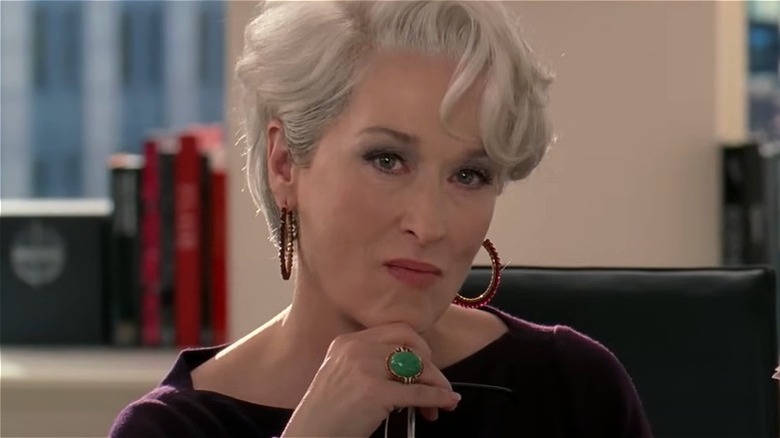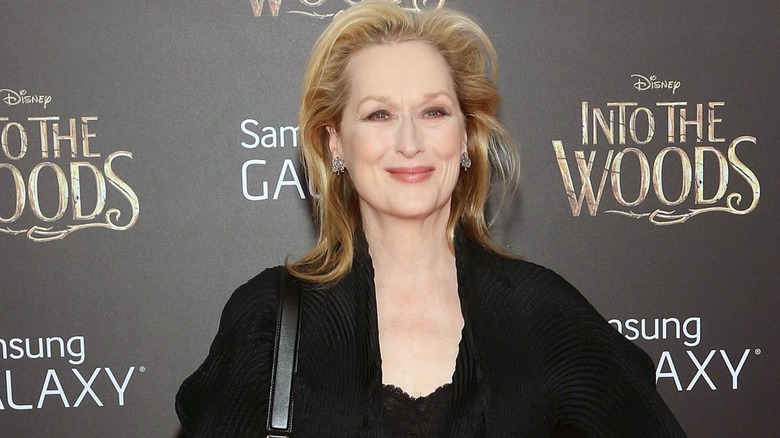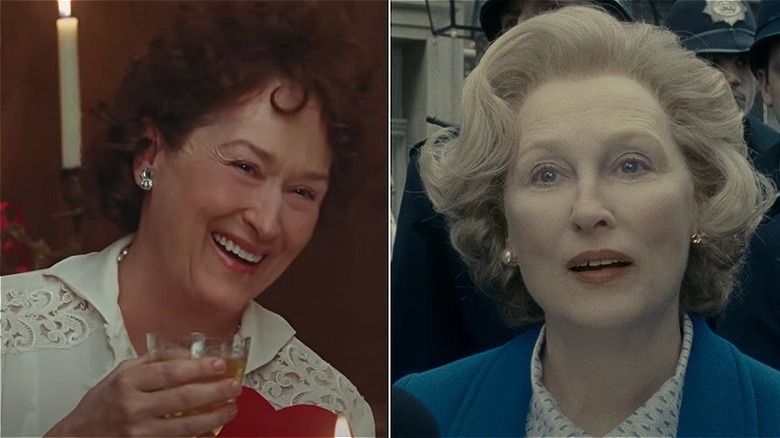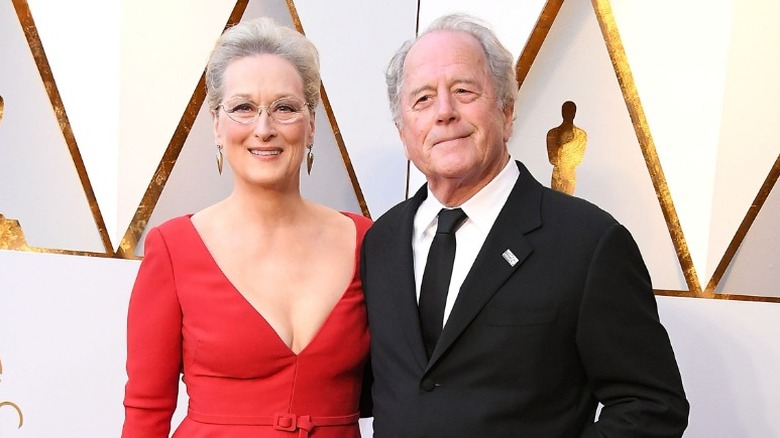Meryl Streep Has Had Quite The Transformation
Meryl Streep is one of Hollywood's most celebrated actors of all time. Over the course of her nearly 50 years in front of the camera, Streep has earned a staggering 21 Oscar nominations and three Academy Awards, not to mention Emmys, Screen Actors Guild (SAG) Awards, and a slew of lifetime achievement awards. Growing up in New Jersey, the young Streep showed both an interest in and a talent for performance. Her chameleon-like ability to craft characters not only allowed her to excel on the stage but also helped her fit in during her school days. Soon, Streep was seriously honing her craft at Vassar and Yale, and after her training, she took Broadway by storm.
Although a gifted actor, her foray into screen acting wasn't as seamless as you would think. Some people even considered Streep too ugly for Hollywood. But her undeniable knack for character couldn't be contained, whether it was costume dramas, true-life thrillers, irreverent comedies, or dazzling musicals. Streep could, and does, master them all. So how did this opera-singing cheerleader rise to the top of Tinseltown and become one of the world's great thespians? Read on to discover the stunning transformation of Meryl Streep.
She was a cheerleader with a penchant for opera
Mary Louise Streep was born in New Jersey in 1949. She was given the nickname Meryl by her mom (her grandmother was also named Mary Louise). From a young age, Streep's curiosity was encouraged by her parents, particularly her mother, who would bring young Meryl to New York City to see Broadway shows and visit museums. She might have been a homecoming queen and a member of the cheerleading squad, but her chipper exterior was character work for Streep.
She revealed during her 2010 Barnard College commencement speech, "In high school, another form of acting took hold of me. I wanted to learn how to be appealing. So I studied the character I imagined I wanted to be. That of the generically pretty high school girl." Streep poured over fashion magazines, ironed her hair, and pined over designer clothes. "I worked harder on this characterization really than anyone that I've done since."
In fact, while Streep was hard at work honing her popular-girl persona, she was also studying to be an opera singer. As a teenager, she studied with noted vocal coach Estelle Liebling. Young Streep didn't care much for the genre, and like many kids, she listened to The Beatles and Bob Dylan, but she still really liked singing. She even starred in her high school's production of "The Music Man."
As a young actor, her character transformations stole the stage
Young Meryl Streep graduated from Vassar College in 1971, and she quickly moved on to study at the celebrated Yale School of Drama. While there, she acted in the Yale Repertory Theatre. During her time with Yale Rep, she starred in a diverse array of plays, appearing in shows like "The Idiots Karamazov" donning ghastly makeup to play Constance Garnett, [12-13] and contemporary spoofs such as "The Shaft of Love" [12-13]. Even before graduating from Yale with her M.F.A. in 1975, Streep's acting reputation spread. Film Critic David Edelstein wrote in New York Magazine that she was dubbed "the greatest actress in America" by a Yale Drama School instructor.
She scored her first Broadway role, a part in the play "Trelawny of the 'Wells'" before moving to New York City. Her next play, Tennessee Williams' "27 Wagons Full of Cotton," saw Streep tap into her knack for physical transformation. To get into the tawdry and innocently garish Baby Doll, Streep tapped into her knack for character work, choosing to wear prosthetic breasts and an old house dress. Her take on Baby Doll was a hit, even wowing Williams himself.
She became an unlikely movie star with Kramer vs. Kramer
By the late 1970s, Streep was making her mark in the theater world, but she soon took her talents to the screen, and not because she wanted merely to be a Hollywood star. She suffered the indignities of auditioning for a role in the 1976 remake of "King Kong," where Italian producer Dino De Laurentiis allegedly mocked her looks and her intelligence. Jessica Lange got the part, and, not losing a step, Streep continued her theater work. That year, she was cast in Shakespeare's "Measure for Measure," co-starring with actor John Cazale. Their chemistry was undeniable on stage, and it was equally palpable off stage as well.
The "Measure" co-stars quickly became a real-life couple, and the truth about Meryl Streep and John Cazale's relationship was that it was intense and tragically short-lived. Cazale was diagnosed with terminal lung cancer in 1977, the same year Streep made her film debut in "Julia." She took on work like the TV mini-series "Holocaust" to help pay Cazale's medical bills, and she had the opportunity to co-star with him in the Vietnam War movie "The Deer Hunter." Sadly, Cazale died in 1978, but it was his passing that partially influenced her casting in arguably her breakout movie, "Kramer vs. Kramer." Despite Meryl Streep and Dustin Hoffman's tense on-set conflict during the production of the film, "Kramer vs. Kramer" became a generational touchstone, and it swept the Academy Awards, including Streep's first Oscar.
Streep solidifies her Hollywood power status with serious costume dramas
Meryl Streep might have won her first Oscar for playing the contemporary character of Joanna Kramer, but she quickly pivoted her career with a number of period-piece dramas that skillfully deployed her character-acting abilities. Streep transformed herself into two characters in 1981's "The French Lieutenant's Woman." She played both Sarah, a 19th century English woman, and the contemporary American actor, Anna.
While Streep nails both parts, it was Sarah's meticulously recreated Victorian era wardrobe of whale bone corsets that pushed the star a bit too far. She told the CBC that making a costume drama was fun, but wearing the corseted dress made of nine yards of green wool for hours on end was extremely painful, not to mention stinky.
The following year, Streep ditched the pinching whalebone and wool for more breathable costuming in the film "Sophie's Choice." She played the complicated title character, a Polish immigrant in the 1940s who experienced the horrors of the Holocaust first-hand. Her glamorous curls, bright red lips, and flouncy dresses crafted a sensuality that obscured her internal suffering. Streep was nominated for Oscars for both films, and she won her second Academy Award for "Sophie's Choice." No matter that a Hollywood stalwart like Katherine Hepburn wasn't a fan of Meryl Streep's more intellectual approach to acting, Streep was clearly now a formidable star in her own right.
She proved she could play contemporary, too
Sure, Meryl Streep quickly built a serious reputation from her historical dramas, but she proved she could act in contemporary films as well. By the early 1980s, Streep was on a career roll, and that wasn't by accident. Talking to the American Film Institute in 1983, she said, "I'm always afraid to turn down jobs. I would never turn one down if it looked like I could do it. I've taken every good part that came along." Streep was quickly becoming known for her time capsule-esque physical transformations and uncanny accent work, but she proved she could take on modern characters with an equal level of craftsmanship and attention to detail.
In the 1983 drama "Silkwood," she rocked a mullet as real-life nuclear facility employee and union activist Karen Silkwood. The costuming helped inform her "Silkwood" performance, with Streep channeling the character through cowboy boots and jean jackets, a far cry from the hoop skirts and bonnets from her recent past. She kept things contemporary in the 1986 comedic drama, "Heartburn," based on writer Nora Ephron's relationship with journalist Carl Bernstein. Streep yet again took on another contemporary character in 1988's "A Cry in the Dark," starring as Lindy Chamberlain, an Australian woman who was wrongfully convicted of killing her child. The New York Times praised Streep's acting in "Dark" for layered performance and acting prowess.
Streep made hair washing seriously sexy in Out of Africa
Meryl Streep didn't make a name for herself in Hollywood as a sex symbol, but she heated up the big screen with a very sensual yet chaste scene in the 1985 film "Out of Africa." Once again, Streep travels back in time to play Karen Blixen, an early 20th-century Danish woman who moves to Africa and falls in love with big-game hunter Denys Finch Hatton (Robert Redford). Based on Blixen's memoir of the same name (published under her pen name, Isak Dinesen), "Out of Africa" is a film chock-full of sweeping landscape, longing gazes, and sexual desires.
But one moment in particular lathered up audiences with its simple intimacy. When Karen's hair becomes tangled, Denys offers to help by washing her hair. A quick scrub and lather (and some poetry recited by Denys) is a moment of delicious pleasure for Karen. To think, Streep was almost not considered for the role by director Sydney Pollack. "I'd heard that Sydney thought I was a very good actress, but didn't know if I was sexy enough," Streep said in a 1997 interview. Ever the performer, she strategized her audition. "I went to my audition wearing something very low cut. Cheap, but it worked."
Streep surprised audiences with her campy comedic talents
By the late 1980s, Meryl Streep was one of Hollywood's most formidable dramatic actors, but unbeknownst to almost everyone, she had a seriously funny side that was ready to show the world. In 1991, she revealed to The New York Times that she had wanted to do comedy for a long time, "but I just never thought anything that was around was funny." Finally, she found a project that tickled her funny bone with 1989's "She-Devil." Streep went full-camp as wealthy romance novelist Mary Fisher.
After "She-Devil," Streep went on a comedy streak. She took on "Postcards from The Edge," based on actor and author Carrie Fisher's relationship with her own mother, Hollywood legend Debbie Reynolds. Then, she co-starred with comedian Albert Brooks in his afterlife fantasy film "Defending Your Life." Her comedy career went blockbuster with her turn as aging actor Madeline Ashton in the special-effects satire, "Death Becomes Her." A special effects-laden affair that literally made Streep's head turn, "Death" was another chance for Streep to showcase her razor-sharp comic timing and wit. "Death Becomes Her" didn't have a lively box office upon its 1992 release, but it's been revived in recent years as an endearing gay cult classic.
She became a full-fledged action hero
Meryl Streep once again transformed her acting career in the 1990s, with the star taking an unexpected yet lucrative turn as a bona-fide action hero. Before she made "The River Wild," Streep's career was perceived to be in a middle-aged slump. The 1994 thriller stars Streep as Gail Hartman, a former river guide who is forced to navigate treacherous white-water rapids by gun-toting thieves. On why she took part, Streep said to The New York Times, "The elements of outdoor river adventure were so appealing," adding, "Besides, I couldn't believe they wanted me for it. I thought they'd get somebody younger and stronger."
Streep trained hard for months for "The River Wild," filming mostly her own stunts. Her rowing coach, Elizabeth H. O'Leary, was impressed with Streep's dedication. "Meryl Streep is an absolutely remarkable woman. She came having learned little about rowing, but it wasn't so much that I had to teach her," O'Leary shared with The Harvard Crimson. "She sees it and she can do it." But just because she could do it, doesn't mean she wasn't scared. She exclaimed to CBS 8 San Diego, "I was motivated by fear, and adrenaline, and the limits that my exertion would take me." The success of "Wild" boosted Streep's money-making abilities. It bumped her payday and gave her more Hollywood power. Not too bad for an actor who had almost been considered washed up.
Streep reached fashion icon status with The Devil Wears Prada
Meryl Streep continued to wow audiences through the 2000s with award-winning roles in projects such as the TV mini-series "Angels in America," but it was her turn as fashion magazine editor Miranda Priestly in "The Devil Wears Prada" that once again solidified the actor's iconic status. Yet again, Streep had her naysayers when it came to casting. On the "Hollywood Gold" podcast, "Prada" producer Wendy Finerman said people didn't think Streep was funny enough for the part (clearly, they weren't following her career in the early '90s).
Streep scored the part of the icy editor of the fictional Runway magazine. Her perfectly coiffed white hair, steely stare, and cool yet cutting leadership style had people instantly comparing Streep's character concoction to Anna Wintour, the long-standing editor of Vogue magazine. But it turns out that Streep found inspiration not from Wintour but from an amalgamation of powerful men. She revealed to Variety, "The voice I got from Clint Eastwood. He never, ever, ever raises his voice and everyone has to lean in to listen, and he is automatically the most powerful person in the room. But he is not funny. That I stole from [director] Mike Nichols." And she also looked to, well, herself. "The walk, I'm afraid, is mine." Ironically, the one item Meryl Streep kept from "The Devil Wears Prada" was Miranda's sunglasses. Perhaps a nod to Wintour's penchant for shades? Groundbreaking.
She reminded the world she can sing
A trained operatic vocalist in her youth, Meryl Streep didn't really share her singing pipes until appearing in several musical films in the 2000s and 2010s. Surprisingly, Streep missed out on musical stardom back in the '90s when she lost the role of Eva Perón to Madonna in the big-screen adaptation of the musical "Evita." At the time, Streep was seemingly miffed about missing out. Of Madonna's talents, Streep expounded to The New York Times, "I could rip her throat out. I can sing better than she can, if that counts for anything." But Streep's time to shine would come soon enough when she starred in the sun-soaked movie version of "Mamma Mia!" in 2008. A delicious jukebox musical set to the music of ABBA, she belted out tunes like "Mamma Mia!" and "Money, Money, Money" without missing a beat.
Streep returned to the genre in 2014, starring as Witch in "Into the Woods." Singing Stephen Sondheim's music required a different level of preparation for Streep. "I really worked hard to get my voice back," she told The Wall Street Journal at the "Into the Woods" premiere. "I used to have a pretty good voice. And then, you know, when you're in your 20s, you're smoking and you're an idiot, and you're screaming at kids in your 30s.” Just listen to her vocal gymnastics in songs like "Last Midnight," and it's obvious Streep put in the practice time.
Streep's transformations into real-life grande dames Julia Child and Margaret Thatcher
Some of Meryl Streep's most stunning character transformations happened well into her decades-long career when she took on two very influential and different real-life women. Streep portrayed pioneering chef and cookbook author Julia Child in the 2009 film, "Julie & Julia." Child's former protégé Sara Moulton told The Daily Beast that Streep correctly captured her former boss's distinctive voice, awkward body language, and assertive attitude.
For Streep, taking on the part of the celebrated cook didn't come naturally. In an interview with The Telegraph, Streep said, "To cook well takes practice and to be honest I feel much more confident about my acting skills than my cooking skills." However, Streep admitted to "Fresh Air" that she became a better cook after taking the part.
In 2011, Streep played another powerful woman, British Prime Minister Margaret Thatcher, in "The Iron Lady." For Streep, portraying the divisive 20th-century figure was not just about the grand moments of Thatcher's political career, but also about capturing what happens when it's all over. The film examined, according to Streep in conversation with Film4, "What it's like to be an old lady and ignored by society in general. What it's like to lose power." For her uncanny physical and emotional transformation into Thatcher, both Streep and her long-time makeup artist Roy Helland won Oscars.
Streep's marriage ends, but her rumors about her dating life heat up
While Meryl Streep has spent nearly half a century honing her craft for public audiences, she's kept her personal life mostly out of the spotlight. She married sculptor Don Gummer in 1978, shortly after the death of her long-time love, John Cazale. The couple had four children together, and over the years, they moved their family from Connecticut to New York. The under-the-radar nature of Streep's marriage contributed to the shock that followed the announcement of her separation from her husband of over 40 years.
In 2023, Streep's spokespeople confirmed to People magazine that not only was her romantic relationship with Gummer over, but that it had been for six years. The rumored reasons why Meryl Streep and Don Gummer split varied from the rebound nature of their relationship to busy work schedules.
While Streep, through her reps, publicly acknowledged her changing marital status, it didn't stop speculation that she had moved on with someone else. Streep quickly became romantically linked to her "Only Murders in the Building" co-star Martin Short. Short's reps denied the rumors to People in 2024, stating they were just friends. But the duo was spotted doing very couple-esque things like going out to dinner at hot celeb restaurant Giorgio Baldi and catching a Broadway show together.

